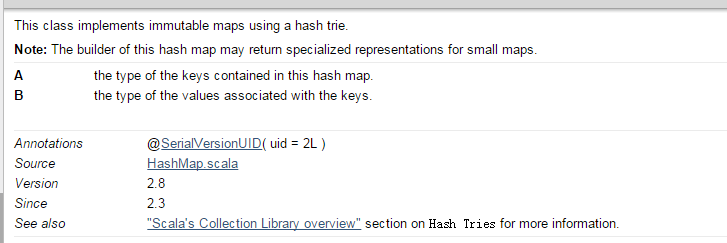本节主要内容
- 泛型(Generic Type)简介
- 注解(Annotation)简介
- 注解常用场景
1. 泛型(Generic Type)简介
泛型用于指定方法或类可以接受任意类型参数,参数在实际使用时才被确定,泛型可以有效地增强程序的适用性,使用泛型可以使得类或方法具有更强的通用性。泛型的典型应用场景是集合及集合中的方法参数,可以说同Java一样,Scala中泛型无处不在,具体可以查看scala的api
1 泛型类
class Person[T](var name:T)
class Student[T](name:T) extends Person(name)
object GenericDemo {
def main(args: Array[String]): Unit = {
println(new Student[String]("摇摆少年梦").name)
}
}
多个泛型参数的使用情况:
class Person[T](var name:T)
class Student[T,S](name:T,var age:S) extends Person(name)
object GenericDemo {
def main(args: Array[String]): Unit = {
println(new Student[String,Int]("摇摆少年梦",18).name)
}
}
D:\ScalaWorkspace\ScalaChapter16\bin\cn\scala\xtwy>javap -private Person.class
Compiled from "GenericDemo.scala"
public class cn.scala.xtwy.Person<T> {
private T name;
public T name();
public void name_$eq(T);
public cn.scala.xtwy.Person(T);
}
D:\ScalaWorkspace\ScalaChapter16\bin\cn\scala\xtwy>javap -private Student.class
Compiled from "GenericDemo.scala"
public class cn.scala.xtwy.Student<T, S> extends cn.scala.xtwy.Person<T> {
private S age;
public S age();
public void age_$eq(S);
public cn.scala.xtwy.Student(T, S);
}
- 1
- 2
- 3
- 4
- 5
- 6
- 7
- 8
- 9
- 10
- 11
- 12
- 13
- 14
- 15
- 16
- 17
- 1
- 2
- 3
- 4
- 5
- 6
- 7
- 8
- 9
- 10
- 11
- 12
- 13
- 14
- 15
- 16
- 17
从上面的代码不难看出,scala泛型对应于java中的泛型,掌握了java中的泛型也就掌握了scala中的泛型
2. 注解(Annotation)简介
Annotation是一种对程序代码进行描述的结构化信息。Annotation可以分布在程序的任何地方,能够注解变量、类、方法、参数等多种元素,它的主要功能有以下几种:
1 自动生成scala文档
scala.collection.immutable.HashMap类对应部分源码:
/** This class implements immutable maps using a hash trie.
*
* '''Note:''' The builder of this hash map may return specialized representations for small maps.
*
* @tparam A the type of the keys contained in this hash map.
* @tparam B the type of the values associated with the keys.
*
* @author Martin Odersky
* @author Tiark Rompf
* @version 2.8
* @since 2.3
* @see [[http://docs.scala-lang.org/overviews/collections/concrete-immutable-collection-classes.html#hash_tries "Scala's Collection Library overview"]]
* section on `Hash Tries` for more information.
* @define Coll `immutable.HashMap`
* @define coll immutable hash map
* @define mayNotTerminateInf
* @define willNotTerminateInf
*/
@SerialVersionUID(2L)
class HashMap[A, +B] extends AbstractMap[A, B]
with Map[A, B]
with MapLike[A, B, HashMap[A, B]]
with Serializable
with CustomParallelizable[(A, B), ParHashMap[A, B]]
{
- 1
- 2
- 3
- 4
- 5
- 6
- 7
- 8
- 9
- 10
- 11
- 12
- 13
- 14
- 15
- 16
- 17
- 18
- 19
- 20
- 21
- 22
- 23
- 24
- 25
- 1
- 2
- 3
- 4
- 5
- 6
- 7
- 8
- 9
- 10
- 11
- 12
- 13
- 14
- 15
- 16
- 17
- 18
- 19
- 20
- 21
- 22
- 23
- 24
- 25
上述annotation生成的文档内容如下:

2 检查程序中可能出现的语法问题
//当程序使用该API时,给出相应提示,属于语法检查范畴
@deprecated("Use the `merged` method instead.", "2.10.0")
def merge[B1 >: B](that: HashMap[A, B1], mergef: MergeFunction[A, B1] = null): HashMap[A, B1] = merge0(that, 0, liftMerger(mergef))
3 规定程序行为
class Student[T,S](name:T,var age:S) extends Person(name)
{
@BeanProperty var studentNo:String=null
}
当然,annotation还有其它功能,上面三种只是平时在编写程序时最为常用的功能
annotation具有如下语法格式:
class A
class B extends A{
@deprecated def getName()="Class B"
}
object AnnotationDemo{
def main(args: Array[String]): Unit = {
var b=new B()
b.getName()
}
}
3. 注解常用场景
注解的常用场景包括volatile,transient,native,SerialVersionUID,serializable5个,用于对变量或方法进行注解,其中volatile用于标识变量可能会被多个线程同时修改,它不是线程安全的;transient用于标识变量是瞬时的,它不会被持久化;native用于标识算法来自C或C++代码实现
abstract class A
{
@native def cplusplusMethod()
}
@SerialVersionUID(1000330L)
@serializable
class B extends A{
@volatile var name:String="B"
@transient var age:Int=40
}
- 1
- 2
- 3
- 4
- 5
- 6
- 7
- 8
- 9
- 10
- 11
- 12
- 13
- 14
- 15
- 16
- 17
- 18
- 19
- 20
- 1
- 2
- 3
- 4
- 5
- 6
- 7
- 8
- 9
- 10
- 11
- 12
- 13
- 14
- 15
- 16
- 17
- 18
- 19
- 20
下面举下对象序列化的例子:
//下面的代码编译时不会出问题,但执行时会抛出异常
class Person{
var name:String="zzh"
var age:Int=0
override def toString()="name="+name+" age="+age
}
object Serialize {
def main(args: Array[String]): Unit = {
val file = new File("person.out")
val oout = new ObjectOutputStream(new FileOutputStream(file))
val person = new Person
oout.writeObject(person)
oout.close()
val oin = new ObjectInputStream(new FileInputStream(file))
val newPerson = oin.readObject()
oin.close()
println(newPerson)
}
}
Exception in thread "main" java.io.NotSerializableException: cn.scala.xtwy.serialize.Person
at java.io.ObjectOutputStream.writeObject0(Unknown Source)
at java.io.ObjectOutputStream.writeObject(Unknown Source)
at cn.scala.xtwy.serialize.Serialize$.main(Serialize.scala:22)
at cn.scala.xtwy.serialize.Serialize.main(Serialize.scala)
- 1
- 2
- 3
- 4
- 5
- 6
- 7
- 8
- 9
- 10
- 11
- 12
- 13
- 14
- 15
- 16
- 17
- 18
- 19
- 20
- 21
- 22
- 23
- 24
- 25
- 26
- 27
- 28
- 29
- 1
- 2
- 3
- 4
- 5
- 6
- 7
- 8
- 9
- 10
- 11
- 12
- 13
- 14
- 15
- 16
- 17
- 18
- 19
- 20
- 21
- 22
- 23
- 24
- 25
- 26
- 27
- 28
- 29
此时在Person类前加@serializable则可以对对象进行正常序列化
@serializable
class Person{
var name:String="zzh"
var age:Int=0
override def toString()="name="+name+" age="+age
}
object Serialize {
def main(args: Array[String]): Unit = {
val file = new File("person.out")
val oout = new ObjectOutputStream(new FileOutputStream(file))
val person = new Person
oout.writeObject(person)
oout.close()
val oin = new ObjectInputStream(new FileInputStream(file))
val newPerson = oin.readObject()
oin.close();
println(newPerson)
}
}
- 1
- 2
- 3
- 4
- 5
- 6
- 7
- 8
- 9
- 10
- 11
- 12
- 13
- 14
- 15
- 16
- 17
- 18
- 19
- 20
- 21
- 22
- 23
- 24
- 25
- 1
- 2
- 3
- 4
- 5
- 6
- 7
- 8
- 9
- 10
- 11
- 12
- 13
- 14
- 15
- 16
- 17
- 18
- 19
- 20
- 21
- 22
- 23
- 24
- 25
如果给成员变量加@transient注解的话,则相应的成员变量不会被序列化,此时如果进行反序列化的话,对应成员变量为null,如:
package cn.scala.xtwy.serialize
import java.io.File
import java.io.ObjectOutputStream
import java.io.FileOutputStream
import java.io.ObjectInputStream
import java.io.FileInputStream
@serializable
class Person{
@transient var name:String="zzh"
var age:Int=0
override def toString()="name="+name+" age="+age
}
object Serialize {
def main(args: Array[String]): Unit = {
val file = new File("person.out")
val oout = new ObjectOutputStream(new FileOutputStream(file))
val person = new Person
oout.writeObject(person)
oout.close()
val oin = new ObjectInputStream(new FileInputStream(file))
val newPerson = oin.readObject()
oin.close();
println(newPerson)
}
}























 420
420

 被折叠的 条评论
为什么被折叠?
被折叠的 条评论
为什么被折叠?








